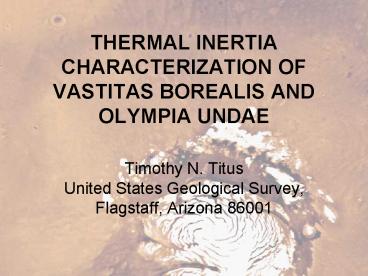THERMAL INERTIA CHARACTERIZATION OF VASTITAS BOREALIS AND OLYMPIA UNDAE - PowerPoint PPT Presentation
THERMAL INERTIA CHARACTERIZATION OF VASTITAS BOREALIS AND OLYMPIA UNDAE
Successfully used KRC Thermal Model combined with TES observations to detect ... TES Albedo & Thermal Bolometer Observations. Restricted to Late-Spring & Summer ... – PowerPoint PPT presentation
Title: THERMAL INERTIA CHARACTERIZATION OF VASTITAS BOREALIS AND OLYMPIA UNDAE
1
THERMAL INERTIA CHARACTERIZATION OF VASTITAS
BOREALIS ANDOLYMPIA UNDAE
- Timothy N. Titus
- United States Geological Survey, Flagstaff,
Arizona 86001
2
Motivation Background
- GRS Suite of Instruments
- High Concentrations of WEH measurements in polar
regions. - WEH minimum in Eastern Olympia Undae.
- TES KRC
- Successfully used KRC Thermal Model combined with
TES observations to detect water ice at edge of
the SPRC
3
The Thermal Model
- TES Albedo Thermal Bolometer Observations
- Restricted to Late-Spring Summer
- KRC Two-Layer Model
- Surface Layer Thermal Inertia
- Surface Layer Depth
- Bottom Layer Thermal Inertia
- Model Fits
- Time-dependent Albedo
- Constant Dust Opacity of 0.2
Depth
Thermal Inertia
Thermal Inertia
4
Top Layer Thermal Inertia
5
Lower Layer Thermal Inertia
6
Top Layer Depth (mm)
7
Cross-SectionLatitude 80.5N
- 5-10 cm of sand on top of ice
8
Cross-SectionLatitude 80.5N
- 5-10 cm of sand on top of ice
9
Cross-SectionLongitude 179 E
- Ice Table Edge is 66N
10
Cross-SectionLongitude 179 E
- Ice Table Edge is 66N
11
Cross-SectionLongitude 189 E
- Ice Table Edge is 67N
12
Cross-SectionLongitude 189 E
- Ice Table Edge is 67N
13
Cross-SectionLongitude 221 E
- Ice Table Edge is south of 65N
14
Cross-SectionLongitude 221 E
- Ice Table Edge is south of 65N
15
Results
- Olympia Undae is frozen with 5-10 cm overburden
of sand. (Consistent with papers by Mary Bourke
and Bill Feldman et al.) - The thermal edge of the ice table is consistent
with that derived from neutrons. - Low hydrogen detection in Olympia Undae
corresponds to a deeper ice table. - The ice table may have a thermal inertia higher
than that expected for either bedrock or pure
ice. - Could be an effect from non-atmospherically
corrected albedo - Possible Implications for formation mechanisms
16
Future Work
- New MDAP Funding
- 60km resolution
- Both Polar Regions
- Variable Opacity
- Atmospherically-corrected albedo
- Combine with Mars Odyssey Neutron Spectrometer
observations
PowerShow.com is a leading presentation sharing website. It has millions of presentations already uploaded and available with 1,000s more being uploaded by its users every day. Whatever your area of interest, here you’ll be able to find and view presentations you’ll love and possibly download. And, best of all, it is completely free and easy to use.
You might even have a presentation you’d like to share with others. If so, just upload it to PowerShow.com. We’ll convert it to an HTML5 slideshow that includes all the media types you’ve already added: audio, video, music, pictures, animations and transition effects. Then you can share it with your target audience as well as PowerShow.com’s millions of monthly visitors. And, again, it’s all free.
About the Developers
PowerShow.com is brought to you by CrystalGraphics, the award-winning developer and market-leading publisher of rich-media enhancement products for presentations. Our product offerings include millions of PowerPoint templates, diagrams, animated 3D characters and more.































